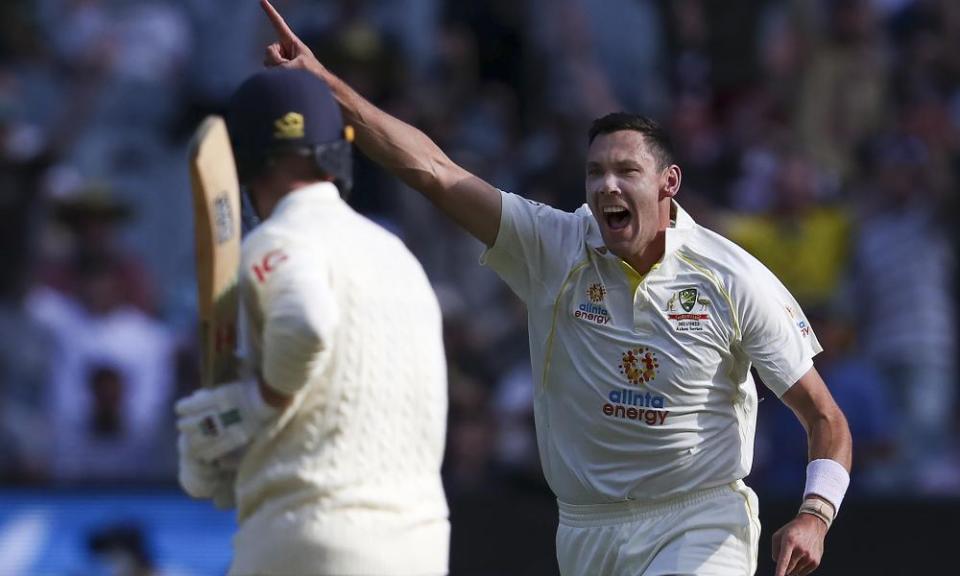Boland’s starring role for Australia adds extra layer of significance
There were four moments across the first two days of the third Ashes match when the Melbourne Cricket Ground rose, in movement and in voice, to the hometown bowler Scott Boland on his Test debut. The second time was when he took his first wicket, as Mark Wood’s dismissal was upheld by the video umpire. The third time was when Boland, batting at No 11, scored his first runs with an edge through the slip cordon.
Related: Late-career Jimmy Anderson chasing lost causes in failing England team | Jonathan Liew
Those either side were more important. The first, before the match began, when Aunty Joy Murphy Wandin spoke during the welcome to country, noting the rarity of an Indigenous Australian cricketer representing this team. The guttural vocal affirmation from the stands was spontaneous and moving.
The fourth time was right at the end of the second day, in the shadow of stumps, when Boland ripped out two English wickets in the space of three balls, his first major influence on the match. Had England ended the day two wickets down, they would have stayed in the contest. At four down, the calculus had drastically changed.
Boland’s story is in many ways representative of the treatment of Indigenous Australians in the nation’s modern incarnation. He did not know of his heritage until he was in his 20s, when his family learned that Boland’s grandfather was descended from the Gulidjan people of western Victoria. For so many people and for so long, that kind of heritage had been hidden or ignored. The Boland family embraced it instead, in a process of learning that is still under way.
In 2018 I spoke to Boland about this. “Me and my brother [Nick] are both similar,” he said. “We didn’t know what to think at first, but the more we spoke about it with our family and the more people we got to meet through the [Cricket Australia] Indigenous programme, the more we understood about where we fit in and how we could help out. Me and Dan Christian chatted about it, and Ben Abbatangelo who was captaining the Australian Indigenous side. So the more we spoke about it, the more we felt comfortable about being involved.”
There is no way to flatter Australian cricket’s history with Indigenous people. It is a gulf in the game. Unaarrimin and Murrumgunarrimin, often recorded by the colonial names of Johnny Mullagh and Twopenny, played one first-class match apiece for Victoria and New South Wales respectively in the 1800s. Jack Marsh and Alec Henry played a handful of state matches at the turn of the 20th century, as did Eddie Gilbert in the 1930s. The latter three were all pushed out of the game by spurious rejection of their bowling actions by white umpires and administrators. Two more known Aboriginal cricketers played first-class matches between Gilbert’s last in 1936 and Jason Gillespie’s first in 1995.

Until Boland, Gillespie was the only Indigenous man to play Test cricket for Australia, while Faith Thomas in 1958 and Ashleigh Gardner starting in 2019 are the only women. Where Australian rules football and rugby league are now rich with Indigenous heroes, cricket still lags behind. The path to changing this remains long and difficult.
All of which means that Boland’s appearance in a baggy green cap would have been hugely significant no matter what he did on the field. The extra layer was added with his dramatic final over on the second day. He was picked in this Ashes XI not for symbolism but for his ability to bash the ball into an often unresponsive MCG deck, where he had previously taken 91 first-class wickets at an average of 25 while others have struggled.
Related: Australia close to securing Ashes despite England bowlers’ fightback
The England opener Haseeb Hameed had survived a devastating opening burst from Pat Cummins and Mitchell Starc, getting through 30 deliveries and driving Starc down the ground for four. It was a quintessential Boland delivery that knocked him over, a ball slammed into the surface so that it jumped off the seam and took the edge of a haplessly wielded bat. Then England’s use of a nightwatchman came undone, Jack Leach studiously leaving his second delivery on a wider line only to hear it clip his off stump after jagging back in. The spectators lifted in time with Boland’s raised fist.
It was a special moment, while one that should not paint a falsely harmonious picture. The MCG is also a ground where Aboriginal champion Adam Goodes was jeered out of Australian rules football after speaking up about the treatment of his people. There remains ugliness aplenty in the relationship between the continent’s original inhabitants and the colonial nation that pushes them to the margins.
“You hear the way people talk in the general community, in general conversation, you would hear their remarks and things like that,” Boland said in that interview. “I think the more that people are educated about different cultures, the more they understand. It’s more mainstream now that Indigenous culture is a big part of Australian history and the Australian community.” There is hope in that, and also the reality that each step forward underlines how many are left to take.
